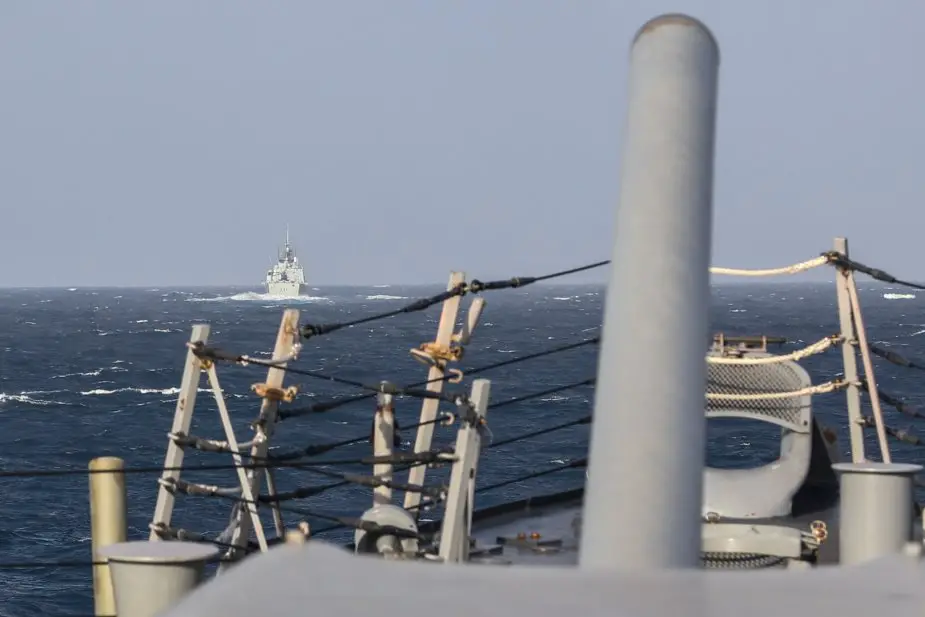Breaking news
US Navy transits Taiwan Strait with Canadian frigate Vancouver.
According to information published by the US DoD on September 21, 2022, Arleigh Burke-class guided-missile destroyer USS Higgins (DDG 76), in cooperation with the Royal Canadian Navy Halifax-class frigate HMCS Vancouver (FFH 331), conducted a routine Taiwan Strait transit.
Follow Navy Recognition on Google News at this link
 The Royal Canadian Navy Halifax-class frigate HMCS Vancouver transits the Taiwan Strait with the guided-missile destroyer USS Higgins while conducting a routine transit. (Picture source: US DoD)
The Royal Canadian Navy Halifax-class frigate HMCS Vancouver transits the Taiwan Strait with the guided-missile destroyer USS Higgins while conducting a routine transit. (Picture source: US DoD)
The ships transited through a corridor in the Strait that is beyond the territorial sea of any coastal State. Higgins’ and Vancouver’s transit through the Taiwan Strait demonstrates the commitment of the United States and our allies and partners to a free and open Indo-Pacific.
The Taiwan Strait is itself a subject of international dispute over its political status. As the People's Republic of China claims to enjoy "sovereignty, sovereign rights and jurisdiction over the Taiwan Strait" and regards the waterway as "internal territorial waters" instead of being international waters, this means that the Chinese government denies any foreign vessel having the freedom of navigation in the strait. This position has drawn strong objections from the United States, Australia, France and Taiwan.
About the frigate HMCS Vancouver
HMCS Vancouver is a Halifax-class frigate, of the Royal Canadian Navy launched on 8 July 1989, as the second vessel of her class. She is based at CFB Esquimalt on the west coast of Canada.
The Halifax-class frigate design of which Vancouver belongs, was ordered by the Canadian Forces in 1977 as a replacement for the aging St. Laurent, Restigouche, Mackenzie, and Annapolis classes of destroyer escorts, which were all tasked with anti-submarine warfare.
In July 1983, the federal government approved the budget for the design and construction of the first batch of six new frigates of which Vancouver was a part, out of twelve that were eventually built.
To reflect the changing long-term strategy of the Navy during the 1980s and 1990s, the Halifax-class frigates was designed as a general purpose warship with particular focus on anti-submarine capabilities.
As built, the Halifax-class vessels displaced 4,750 long tons (4,830 t) and were 134.65 metres (441 ft 9 in) long overall and 124.49 metres (408 ft 5 in) between perpendiculars with a beam of 16.36 metres (53 ft 8 in) and a draught of 4.98 metres (16 ft 4 in).
That made them slightly larger than the Iroquois-class destroyers. The vessels are propelled by two shafts with Escher Wyss controllable pitch propellers driven by a CODOG system of two General Electric LM2500 gas turbines, generating 47,500 shaft horsepower (35,400 kW) and one SEMT Pielstick 20 PA6 V 280 diesel engine, generating 8,800 shaft horsepower (6,600 kW).
This gives the frigates a maximum speed of 29 knots (54 km/h; 33 mph) and a range of 7,000 nautical miles (13,000 km; 8,100 mi) at 15 knots (28 km/h; 17 mph) while using their diesel engines.
Using their gas turbines, the ships have a range of 3,930 nautical miles (7,280 km; 4,520 mi) at 18 knots (33 km/h; 21 mph). The Halifax class have a complement of 198 naval personnel of which 17 are officers and 17 aircrew of which 8 are officers.





























